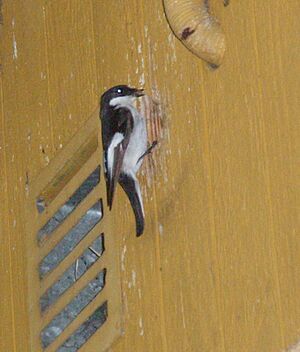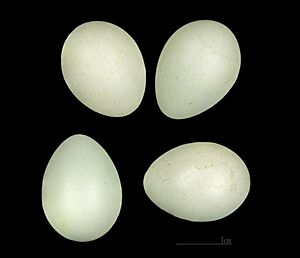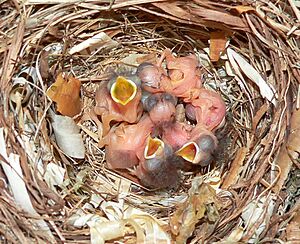European pied flycatcher facts for kids
Quick facts for kids European pied flycatcher |
|
|---|---|
 |
|
| Adult male in Scotland | |
| Conservation status | |
| Scientific classification | |
| Genus: |
Ficedula
|
| Species: |
hypoleuca
|
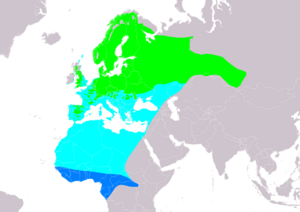 |
|
| Range of F. hypoleuca Breeding Passage Non-breeding | |
| Synonyms | |
|
Muscicapa luctuosa Temm. |
|
The European pied flycatcher (Ficedula hypoleuca) is a small passerine bird. It belongs to the Old World flycatcher family. This bird is known for catching insects while flying. It lives in most parts of Europe and western Asia.
These birds travel long distances. They spend their winters mainly in warm, tropical Africa. European pied flycatchers usually build their nests in holes found in oak trees.
Sometimes, a male flycatcher will have more than one mate. This is called polygyny. The male might travel far to find a second mate. After mating with the second female, he usually returns to his first mate. He helps her with raising the young, like bringing food.
The European pied flycatcher mostly eats insects. But it also enjoys other small creatures like arthropods. They often hunt spiders, ants, and bees. Because there are so many of these birds, they are not considered endangered. The International Union for Conservation of Nature (IUCN) lists them as "least concern."
Contents
About the European Pied Flycatcher
The European pied flycatcher is part of the "Old World flycatcher" family. These are insectivorous songbirds. They usually catch insects while flying. The name ficedula comes from a Latin word. It means "small fig-eating bird." The word hypoleuca comes from Greek. It means "white below."
The scientific name for this bird is Ficedula hypoleuca ([Pallas], 1764). It was named by a German naturalist, Peter Simon Pallas, in 1764.
There are four recognized types, or subspecies, of the European pied flycatcher. These include the main type, F. h. hypoleuca. Others are F. h. speculigera, F. h. iberiae, and F. h. tomensis.
What Does the European Pied Flycatcher Look Like?

This bird is about 12–13.5 centimetres (4.7–5.3 in) long. That's about the length of a pen. During breeding season, the male is mostly black on top and white underneath. He has a big white patch on his wing. His tail sides are white, and he has a small white spot on his forehead.
The type of flycatcher found in the Iberian Peninsula (Spain and Portugal) is called the Iberian pied flycatcher. It has a bigger forehead patch and a lighter rump.
Males not in breeding season, females, and young birds look different. Their black feathers are replaced by a light brown color. It can be hard to tell them apart from other similar flycatchers. One very similar bird is the collared flycatcher. These two species can sometimes breed together.
The flycatcher's beak is black. It is wide but pointed, perfect for catching insects in the air. Besides flying insects, they also hunt caterpillars in oak leaves. They will also eat berries.
These birds live in deciduous woodlands, parks, and gardens. They especially like oak trees. They build open nests inside tree holes. They are also happy to use nestboxes that are open at the front. A female usually lays 4 to 10 eggs.
The Atlas pied flycatcher is very similar. It lives in the mountains of northwest Africa. It used to be considered the same species as the European pied flycatcher.
Where Do European Pied Flycatchers Live?
The European pied flycatcher lives in many countries. You can find them across Europe and northern Africa. They also live in the western part of Russia in Asia.
The main type, F. h. hypoleuca, lives in the UK, central Europe, and Scandinavia. F. h. speculigera lives in Morocco, Algeria, and Tunisia. F. h. iberiae is found in the Iberian Peninsula. And F. h. tomensis lives in eastern Europe and Russia.
These flycatchers spend their winters in tropical Africa. They are sometimes seen in other places like Sudan and Afghanistan. They prefer open forests, woodlands, and even towns. In 2005, there were an estimated 3 to 7 million pairs in Europe.
How Far Do They Travel to Breed?
European pied flycatchers often move between breeding seasons. The distance they move can be from about 52–133 metres (171–436 ft). The average distance between their nest sites is about 45 metres (148 ft). This distance can change depending on how many birds are breeding in an area.
Older birds, both male and female, tend to move shorter distances. They stay closer to their old breeding spots. If a pair stays together, they usually nest near their previous home. If a pair breaks up, the female often moves much farther away than the male.
Reproduction and Mating Habits
Most bird species have one mate, which is called monogamy. But the European pied flycatcher often has more than one mate. This is called polygyny. Scientists have studied why females might choose to mate with a male who already has a partner. This choice can sometimes lead to fewer offspring for the female.
Why Do Males Have More Than One Mate?
One idea is that males try to trick females. A male might set up a second territory far from his first nest. This makes it harder for the second female to know he already has a mate. He might sing loudly to attract her. Once she settles, she might find out he has another family.
Another idea is about female competition. It might be hard for females to find an unmated male. So, they might settle for a male who already has a mate. Having a second territory far away might help reduce fighting between the first and second females.
The first female often visits the second territory. She can act aggressively towards the second female. These visits happen less often if the nests are far apart. It's important for the first female to find an intruder quickly. The longer an intruder stays, the harder it is to make her leave. Female flycatchers can recognize their mate's songs. This helps them check if he has started a second territory.
Becoming Different Species
The European pied flycatcher and the collared flycatcher are very similar. They are slowly becoming two separate species. This is called speciation by reinforcement. It means that nature is selecting against their hybrid offspring.
These two species started to become different less than two million years ago. This is a short time in terms of evolution. But their hybrid offspring already have problems. They have low fertility and issues with their bodies.
When given a choice, females of both species usually choose males of their own kind. This is especially true when both species live in the same area. This shows that they are learning to avoid mating with the wrong species.
Parental Care
Scientists have also studied how much male European pied flycatchers help raise their young. They looked at how much food males brought to the nest.
Monogamous females (those with one mate) and primary females (the first mate of a polygynous male) get much more help from the male. Polygynous females (the second mate) get less help. They can only partly make up for the male's absence. This means they often raise fewer young than monogamous pairs.
Males feed their mates during the egg-laying and incubation stages. This is called Courtship feeding. It is thought to make the bond between the pair stronger. The amount of food a male brings depends on his physical condition. It also depends on the temperature outside.
Polygynous females get less food from their mates. This means they have to spend more time away from the nest to find food for themselves. This can make their eggs take longer to hatch compared to monogamous females.
What Do European Pied Flycatchers Eat?
The European pied flycatcher's diet is almost entirely insects. Their name comes from their habit of catching flying insects. But they also catch insects or other small creatures from tree trunks, branches, or the ground. Studies show they often catch food from the ground.
They catch more flying insects early in the season (May to June). Later in the season (August to September), they catch more insects from trees. They use similar hunting methods as other flycatchers, like the collared flycatcher and the spotted flycatcher.
Their Diet Up Close
A study of their stomach contents during breeding season showed their main diet. It included ants, bees, wasps, and beetles. Ants made up about 25% of their diet.
Young flycatcher chicks eat different things. Their diet includes spiders, butterflies, moths, flies, mosquitoes, ants, bees, wasps, and beetles. They eat more larvae (young insects) of butterflies and moths. For other insects, they eat more adults. Adult flycatchers eat more ants than their chicks do.
Conservation Status
The population of the European pied flycatcher has gone down. On average, it has decreased by 25% in the last 25 years. In some parts of Britain, it no longer breeds. In Ireland, it is very rare. Only one or two pairs are recorded breeding most years.
In the Netherlands, its population has dropped by 90%. This is because the timing of when their young hatch no longer matches when insect food is most available.
Life Cycle
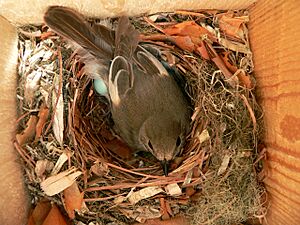
- Mid-September to mid-April: Lives in sub-Saharan Africa.
- Mid-April to end of May: Migrates and arrives in countries like the United Kingdom.
- June to August: Breeding season, usually only one group of young.
- August to mid-September: Flies back to sub-Saharan Africa for winter.
How We Help Them
These birds breed in upland broadleaf woodlands. In Britain, this means they are mostly found in the North and West. They prefer old oak woodlands. But they also breed in old ash and birch woods in upland areas.
They like woodlands where you can see far through the trees. This means not too many shrubs or small plants underneath. But they like a lot of moss and grass. Managing grazing animals helps keep the woodland open. This also allows new trees to grow occasionally.
They sometimes use old, open conifer woodlands. This is if there are natural holes in the trees. They generally prefer trees with holes, like dead trees or dead branches on healthy trees. They also like lichens that grow on trees.
Organizations like the Forestry Commission and Natural England offer grants. These grants help pay for projects that protect and improve the woodlands where these birds live.
Images for kids



